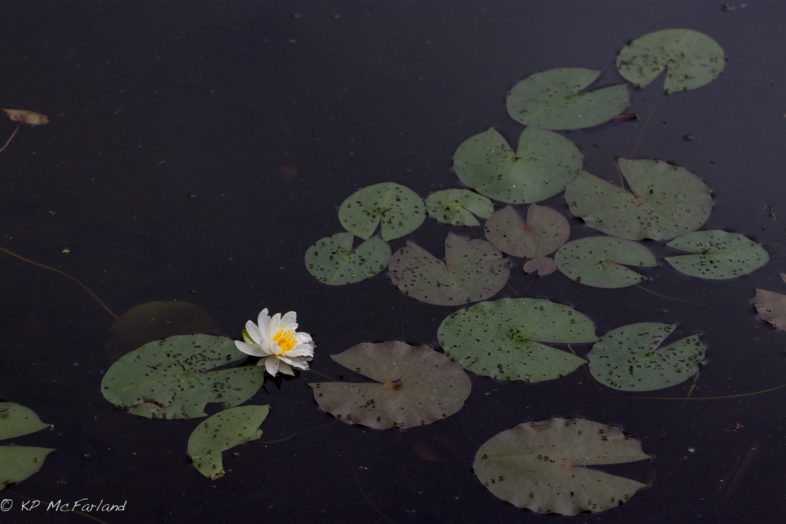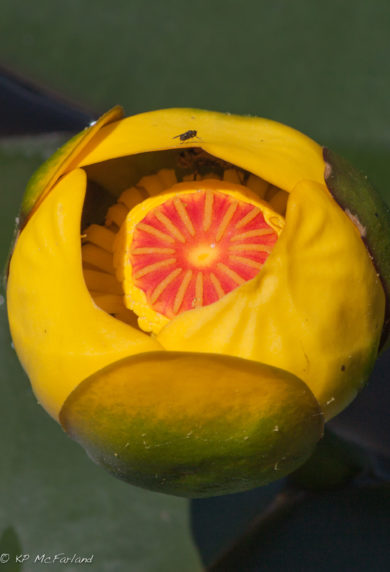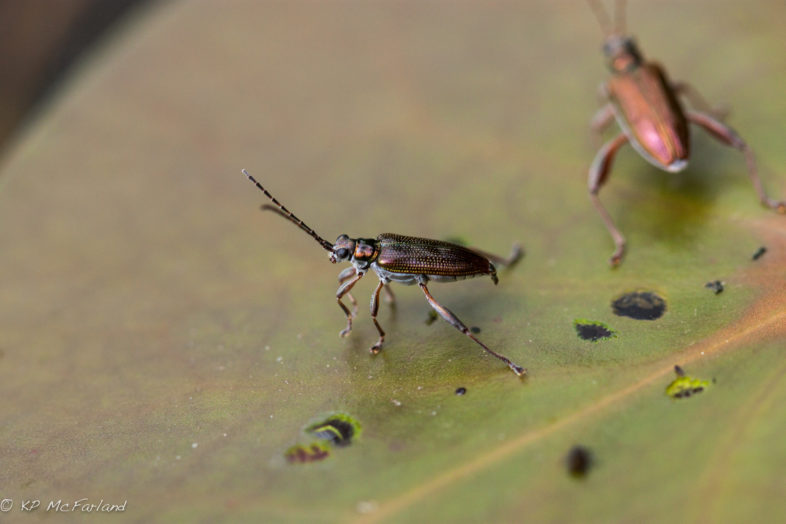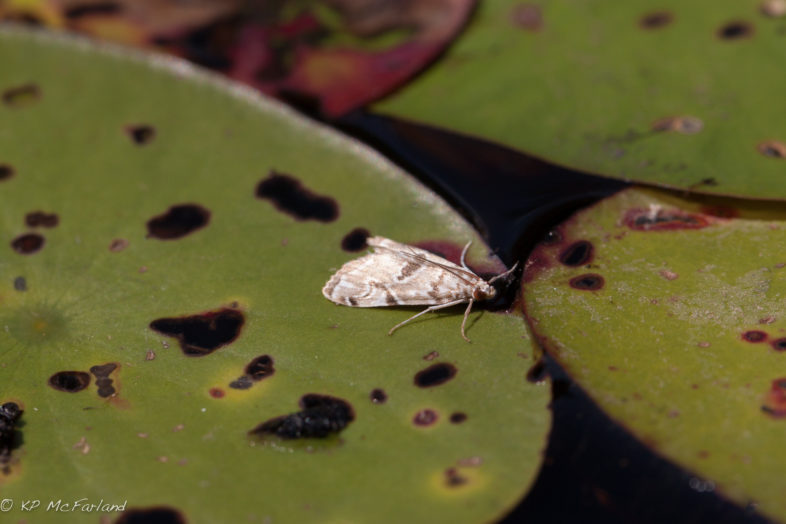At the height of summer many ponds are covered in lily pads with beautiful white or yellow flowers spread across the water. Moose munch on them. Beaver and muskrat devour them. Deer consider them delicious. But peer a little closer and you’ll find an amazing miniature world inhabiting each floating leaf.
In our region there are several plants with floating leaves that one may call ‘lily pads’. From Bullhead Pond-lily (Nuphar variegata) with its bright yellow flower petals and deep orange pistil, to the incredibly fragrant White Water-lily (Nymphaea odorata), or even Water-shield (Brasenia schreberi) with its slimy, gelatinous-covered leaves and tiny, dark red flowers that almost escape notice; they all have specialized adaptations to allow them to rise from the deep muddy bottom up through the water column and into the air.
Water lilies are in a quandary. Their roots need oxygen, but the muck beneath the water is anaerobic. To solve this, they pump up to two liters of air from the surface down to the roots each day during the growing season using a special gas conducting tissue running down the length of stem called the aerenchyma. Air enters tiny openings on the leaf, called stomata. While land plants have them on all surfaces of the leaf, they are only found on the upper surface of water lily leaves. When the sun heats the young leaves it creates a pressure gradient that forces air down the aerenchyma. As leaves age they lose this ability to pressurize air. The roots return carbon dioxide to the surface through these older leaves.
There are many species of water lily leaf beetles that ride and feed on the surface of the lily pads. One of the earliest to emerge with the fresh leaves is named by Latin loving scientists as Galerucella nymphaeae. These oblong, dark-brown beetles are just a quarter of an inch long. They lay eggs on the surface of the leaves in June. Soon, the eggs hatch and the shiny black larvae with yellowish bellies begin to feed on the leaves. They cause the leaves to age more rapidly as they chew through them. During the height of their growth, the beetles can cause them to last just a third as long as uninhabited leaves.
Another group of water lily beetles are called Donacia. The quick moving adults have a golden metallic shine and stand tall on long legs on the lily pads. They have a layer of silky hairs on their underside that helps repel water in their soggy world. Depending on the species, some lay eggs by chewing a hole through the lily pad and then dipping their abdomen below the surface to glue rows of eggs onto the leaf. While other species may bend over the edge of the leaf to cement the eggs or climb under the leaf and down the stem to deposit eggs. Tiny grubs hatch from the eggs after about ten days and fall down through the water column eventually finding their way into the roots of the plant. The larvae have two tiny pores, called spiracles, at the end of their abdomen, each guarded by a spine. They use these as picks to open holes into the air chambers inside the plant stem thereby gaining access to a steady air supply for breathing while they feed on the plant. When ready to pupate, they build a silky, waterproof cocoon from special glands in the mouth and fill them with air by once again cutting holes into the stem’s air chambers. After developing quickly into an adult, they remain underwater until the next spring when they bursts out of the cocoon, and holding air bubbles under the wing covers and body hairs, float to the surface to find a new lily pad home.
You might notice tiny serpentine patterns snaking through the leaf surface. These are from the larvae of leaf-mining midges. Active at dusk, these tiny insects resemble mosquitoes, but don’t bite. The larvae tunnel between the leaf layers, which eventually turn brown and rot through the leaf.
Even moths find a home on water lilies. The caterpillars of the water lily borer moth feed on leaves and tunnel into the stalks of the lily pads. The poetically named polymorphic pondweed moth caterpillars feed on the leaves. As they grow larger they cut and tie two pieces of leaf tissue together and hide in it under the lily pad when they are not feeding. But perhaps the most spectacular feat is that of the water lily moth caterpillar. The adults live for just six days, but in that short time a female can lay up to 900 eggs on the surface of the lily pads. The tiny green caterpillars hatch and begin to feed on the leaves. After three weeks they’ve grown from just a few millimeters to over an inch long, turning a deep red color. Amazingly, the caterpillars swim to land using a porpoise motion with the rear third of their body. Once on land, they build a silk-lined chamber in the soil and pupate.
Flip over a lily pad and you’ll find a floating hatchery holding the eggs of mites, snails, whirligig beetles, caddisflies and others. Freshwater sponges, microscopic tube-dwelling rotifers and bryozoans colonize the surface. Snails crawl across the leaves feeding on algae. Spread across the pond each summer are entire floating worlds, each built on a lily pad.
Comments (10)
Pingbacks (3)
-
[…] of activity, both above and below the water. Kent McFarland, in a July 5, 2016 article on the Vermont Center for Ecosystems website provides a description of their […]





Hi Kent, Do you know the process of lily root mats floating to the surface sometimes covering hundreds of square feet? This occurs on Curtis Pond at both the south and north ends.
And propogation. I’ve received numerous reports of lily pads taking over shallow areas of lakes within 5-10 years.
Eric Hanson
Hi there,
Is there a way to rid moth pupa from my pond?
Thanks,
Amy
Sorry, I have no idea.
Good morning,
What would be the best pond-lilies for our pond in SE Vermont? And where can I purchase them?
Thank you
Lynn
Hi Lynn, I would contact https://www.vermontwetlandplants.com/. They could probably help you find native plants.
Thanks for this lovely post (left here for me to find all these years later! )
The other day I swam up to a patch of white lily to investigate and was looking on the internet for more information… I got just what i wanted here!
There are what I believe to be Nuphar variegata in a beaver pond in Juneau, AK that are brilliant orange. Have you ever seen them that color? Email me, and I can send you a photo.
Hi Kent,
Do you know the name of the tiny plant that has an oval shaped leaf and no discernable flower that seems in the water lily family because it had tendrils down into the water? I am working in the Wells Lamson quarry and see it along the edges in colonies and would like to have an accurate name, not just tiny water lily.
thanks
Just a guess but perhaps it is duckweed? https://www.fs.fed.us/wildflowers/plant-of-the-week/lemna_minor.shtml
Do Lilly roots object to being on the top of an airstone. Do they dislike the oxygen or has anyone tried?
Please do not add me to a mailing list